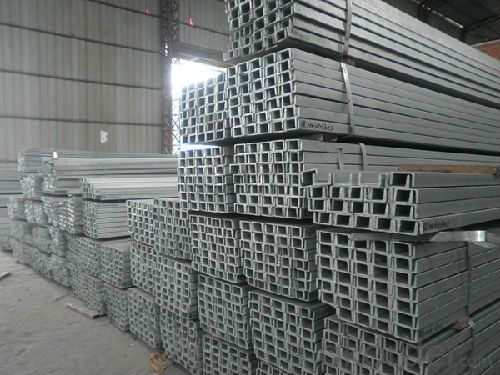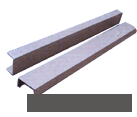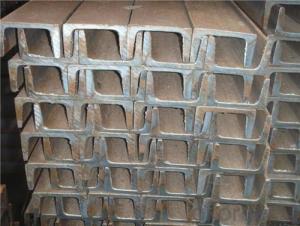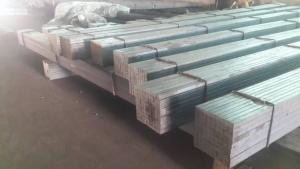80mm*45mm u channel steel for construction
- Loading Port:
- Tianjin
- Payment Terms:
- TT or LC
- Min Order Qty:
- 25 m.t.
- Supply Capability:
- 100000 m.t./month
OKorder Service Pledge
OKorder Financial Service
You Might Also Like
Product Description:
OKorder is offering 80mm*45mm u channel steel for construction at great prices with worldwide shipping. Our supplier is a world-class manufacturer of steel, with our products utilized the world over. OKorder annually supplies products to European, North American and Asian markets. We provide quotations within 24 hours of receiving an inquiry and guarantee competitive prices.
Product Applications:
80mm*45mm u channel steel are ideal for structural applications and are widely used in the construction of buildings and bridges, and the manufacturing, petrochemical, and transportation industries.
Product Advantages:
OKorder's u channel steel are durable, strong, and resist corrosion.
Main Product Features:
· Premium quality
· Prompt delivery & seaworthy packing (30 days after receiving deposit)
· Corrosion resistance
· Can be recycled and reused
· Mill test certification
· Professional Service
· Competitive pricing
Product Specifications:
Specifications of MS Channel:
1.We supply high quality MS Channel at reasonable price, including Chinese standard, Japanese standard and so on.
Standard | GB/JIS |
Material Grade | Q235,SS400 |
Technique: | Hot Rolled |
Sizes as per chinese standard: | 50*37*4.5mm - 300*89*11.5mm |
Sizes as per japanese standard: | 50*25*3mm – 200*80*7.5mm |
Length: | 6meter, 9meter, 12meter |
Note: 1.we are also competent to provide our customers other MS Channel based on other sizes according to customer’s requirements.
2. The length of our ms channel could be cut into other meters as per customer’s requirements. For example, the channel in 6meters could be cut into 5.8meters in order to be fit in the 20ft container.
2. The detailed sections of MS Channel as per GB standard.are shown in the table-1:
GB U CHANNEL | Standard | Sectional | Dimension |
| Mass: |
| (mm) | (mm) | (mm) | (mm) |
|
50X37 | 50 | 37 | 4.50 | 7.0 | 5.438 |
63X40 | 63 | 40 | 4.80 | 7.5 | 6.634 |
80x43 | 80 | 43 | 5.00 | 8.0 | 8.045 |
|
|
|
|
|
|
100x48 | 100 | 48 | 5.30 | 8.5 | 10.007 |
120x53 | 120 | 53 | 5.50 | 9.0 | 12.059 |
140x58 | 140 | 58 | 6.00 | 9.5 | 14.535 |
140x60 | 140 | 60 | 8.00 | 9.5 | 16.733 |
|
|
|
|
|
|
160x63 | 160 | 63 | 6.50 | 10.0 | 17.240 |
160x65 | 160 | 65 | 8.50 | 10.0 | 19.752 |
|
|
|
|
|
|
180x68 | 180 | 68 | 7.00 | 10.5 | 20.174 |
180x70 | 180 | 70 | 9.00 | 10.5 | 23.000 |
|
|
|
|
|
|
200x73 | 200 | 73 | 7.00 | 11.0 | 22.637 |
200x75 | 200 | 75 | 9.00 | 11.0 | 25.777 |
|
|
|
|
|
|
220x77 | 220 | 77 | 7.00 | 11.5 | 24.999 |
220x79 | 220 | 79 | 9.00 | 11.5 | 28.453 |
|
|
|
|
|
|
250x78 | 250 | 78 | 7.00 | 12.0 | 27.410 |
250x80 | 250 | 80 | 9.00 | 12.0 | 31.335 |
250x82 | 250 | 82 | 11.00 | 12.0 | 35.260 |
|
|
|
|
| |
280x82 | 280 | 82 | 7.50 | 12.5 | 31.427 |
280x84 | 280 | 84 | 9.50 | 12.5 | 35.823 |
280x86 | 280 | 86 | 11.50 | 12.5 | 40.219 |
|
|
|
|
|
|
300x85 | 300 | 85 | 7.50 | 13.5 | 34.463 |
300x87 | 300 | 87 | 9.50 | 13.5 | 39.173 |
300x89 | 300 | 89 | 11.50 | 13.5 | 43.883 |
Table-1
3. The chemical composition of HR Channel Steel according to Q235B is shown in Table-2.
Alloy No | Grade | Element(%) | ||||
C | Mn | S | P | Si | ||
Q235 | B | 0.12-0.20 | 0.3-0.7 | ≦0.045 | ≦0.045 | ≦0.3 |
Table-2
Note: we are able to present our customers relevant SGS test report for chemical composition of HR Channel Steel.
4. The mechanical property of HR Channel Steel according to Q235B is shown in Table-3-1 and Table-3-2
Alloy No | Grade | Yielding Strength Point(Mpa) | |||
Thickness(mm) | |||||
≦16 | >16-40 | >40-60 | >60-100 | ||
≧ | |||||
Q235 | B | 235 | 225 | 215 | 205 |
Table-3-1
Alloy No | Grade | Tensile Strength(Mpa) | Elongation After Fracture(%) | |||
Thickness(mm) | ||||||
≦16 | >16-40 | >40-60 | >60-100 | |||
≧ | ||||||
G235 | B | 375-500 | 26 | 25 | 24 | 23 |
Table-3-2
Note: we are able to present our customers relevant SGS test report for mechanical property of MS Channel as customer’s request.
Applications of MS Channel:
The MS Channel can be applied to construction of warehouses, workshops, sport stadiums and car parks etc.The hot rolled channel steel belongs to carbon structural steel which is applied to in the field of construction and machinery.In details, the hot rolled channel steel is usually used for arch-itechtural structure, and they could be welded in order to support or hang a vari-ety of facilities. They are also usually used in combination with I beam. Generally,the hot rolled channel steel we supply must possess perfect welding property, riveting property and mechanical property and so on.
Package & Delivery of MS Channel:
1.The hot rolled channel steel will be packed in bundle with steel wire at each end of every bundle and color marking in order to help the customer to recognize his goods more easily at sight.
2. And the hot rolled channel steel could be loaded into 20ft or 40ft container, or by bulk cargo.If the weight of each bundle reaches more than 3.5 mt, the loading by break bulk cargo should be choosed.When the weight of each bundle reaches less than 3mt, the loading by container should be choosed.
3.As for the transportaion from mill to loading port, the truck will be usually used. And the maximum quantity for each truck is 40mt.
4.All in all, we could do in accordance with customer's request
FAQ:
Q1: Why buy Materials & Equipment from OKorder.com?
A1: All products offered byOKorder.com are carefully selected from China's most reliable manufacturing enterprises. Through its ISO certifications, OKorder.com adheres to the highest standards and a commitment to supply chain safety and customer satisfaction.
Q2: What makes stainless steel stainless?
A2: Stainless steel must contain at least 10.5 % chromium. It is this element that reacts with the oxygen in the air to form a complex chrome-oxide surface layer that is invisible but strong enough to prevent further oxygen from "staining" (rusting) the surface. Higher levels of chromium and the addition of other alloying elements such as nickel and molybdenum enhance this surface layer and improve the corrosion resistance of the stainless material.



- Q:What are some common techniques for using a steel square in furniture repair?
- When it comes to furniture repair, the steel square stands out as a tool that is both versatile and indispensable. Let's explore some commonly employed techniques for utilizing a steel square in furniture repair: 1. Squareness verification: A primary function of the steel square in furniture repair is to ascertain the squareness of corners and joints. By placing the square against the corner or joint, one can determine if it is precisely 90 degrees or if adjustments are required. 2. Angle and line marking: Steel squares often come with markings of various measurements and angles on their surface. These markings serve to accurately mark angles or lines on the furniture piece being repaired. This proves particularly useful when cutting or aligning wood or other materials. 3. Measurement and dimension transfer: Steel squares typically possess a ruler edge that facilitates measuring and transferring dimensions. By aligning the square's ruler edge with the desired measurement, one can accurately mark or transfer the dimensions onto the furniture piece. 4. Flatness checking: In furniture repair, it is crucial to ensure that surfaces are flat and level. A steel square can be deployed to check for flatness by placing it against the surface and observing if any gaps or inconsistencies are present. 5. Assembly alignment: When assembling furniture pieces, a steel square can be used to ensure proper alignment of all components. By placing the square against the assembled parts, one can verify that everything is square and make any necessary adjustments. 6. Center point determination and marking: Steel squares often feature a notch in the center of one edge, which aids in determining the center point of a furniture piece. This proves particularly helpful when marking the center for tasks such as drilling holes. All in all, the steel square emerges as an essential tool in furniture repair, offering accuracy, precision, and versatility. By employing these common techniques, one can guarantee that furniture repairs are executed with the utmost care and professionalism.
- Q:What is the difference between a framing square and a steel square?
- A framing square and a steel square are both tools used in carpentry and construction, but they have different designs and purposes. A framing square is a traditional tool that consists of two arms that meet at a right angle, forming an L-shape. It is typically made of wood, aluminum, or plastic. The longer arm, called the blade, is usually 24 inches long, while the shorter arm, known as the tongue, is usually 16 inches long. Framing squares are used primarily for laying out and measuring right angles, marking and cutting rafters, and checking for squareness in framing and construction projects. On the other hand, a steel square, also known as a combination square or a try square, is a more versatile and precise tool. It is made entirely of steel and typically has a 12-inch blade with a sliding head. The head can be locked at any desired angle, allowing the square to be used for measuring and marking angles other than 90 degrees. Steel squares often have additional features, such as a level, a scribe, or a protractor, making them useful for a wide range of layout and measurement tasks. In summary, the main difference between a framing square and a steel square lies in their design and functionality. A framing square is a basic L-shaped tool used primarily for measuring and marking right angles in framing and construction projects. On the other hand, a steel square is a more versatile and precise tool made entirely of steel, with a sliding head that can be locked at different angles, making it suitable for a wider range of layout and measurement tasks.
- Q:How do you use a steel square to determine the length of a fence?
- To determine the length of a fence using a steel square, you can follow these steps: 1. Start by positioning one end of the steel square against a straight portion of the fence, ensuring it is flush with the ground. 2. Hold the steel square perpendicular to the fence, with the longer side of the square aligned with the top of the fence. 3. While keeping the square in place, count the number of times the shorter side of the square overlaps with the fence. 4. Each overlap indicates one unit of measurement, such as an inch or a foot, depending on the scale of the square. 5. Multiply the number of overlaps by the unit of measurement to determine the length of the fence.
- Q:How do you use a steel square to measure the height of a step?
- To use a steel square to measure the height of a step, you can follow these steps: 1. Place the steel square on the step at the edge, ensuring that it is perpendicular to the step's surface. The longer side of the square should be horizontal, parallel to the ground. 2. Slide the square along the vertical face of the step until the shorter side of the square touches the top edge of the step. 3. Once the square is positioned correctly, take note of the measurement on the longer side of the square where it intersects with the top edge of the step. This measurement will indicate the height of the step. 4. Ensure that the square is held firmly in place to prevent any movement during the measurement process. It is also crucial to ensure that you are reading the measurement accurately. 5. Repeat the process for each step to measure the height consistently.
- Q:How do you use a steel square for marking and cutting half-blind dovetail joints?
- To use a steel square for marking and cutting half-blind dovetail joints, follow these steps: 1. Start by selecting a steel square that has a precise 90-degree angle. This tool will help ensure accurate markings and cuts for your half-blind dovetail joints. 2. Begin by marking the thickness of your dovetail joint on the end grain of the tail board and the face of the pin board. This can be done by holding the steel square against the end grain of the tail board and drawing a line along the inside of the square. Repeat this step on the face of the pin board. 3. Next, you will need to mark the depth of the dovetail joint on both the tail and pin boards. Hold the steel square against the end grain of the tail board and align the blade of the square with the marked thickness line. Draw a line along the blade of the square to mark the depth. Repeat this step on the pin board. 4. Once the thickness and depth lines are marked, position the steel square against the face of the tail board. Align the blade of the square with the marked thickness line on the pin board. This will create a reference line for the shoulder of the dovetail joint. 5. Use a marking knife or a pencil to trace along the blade of the steel square, marking the shoulder line on the face of the tail board. Repeat this step on the face of the pin board. 6. Now, you can mark the angled sides of the dovetail joint. Hold the steel square against the face of the tail board, aligning the blade with the shoulder line. Draw a line along the blade, creating the angle line for the dovetail. Repeat this step on the pin board. 7. With the lines marked, you can now proceed to cut the half-blind dovetail joints using a dovetail saw or a similar cutting tool. Follow the marked lines carefully to ensure accurate and precise cuts. By using a steel square to mark and cut half-blind dovetail joints, you can achieve well-fitted joints that contribute to the strength and aesthetics of your woodworking project. Remember to measure accurately and make precise cuts for the best results.
- Q:Can a steel square be used for checking the squareness of a workbench leg?
- Yes, a steel square can be used for checking the squareness of a workbench leg. A steel square is a versatile tool that is commonly used in woodworking and construction to ensure accurate right angles and squareness. To check the squareness of a workbench leg, you can place the steel square against the leg and the surface it is supposed to be perpendicular to. By aligning the square with the leg and checking if the edges are perfectly perpendicular, you can determine if the leg is square or if it needs adjustments. The steel square provides a reliable and precise measurement for checking squareness in various applications, including workbench legs.
- Q:How is a steel square calibrated?
- The precision machining process is used to calibrate a steel square, also referred to as a framing square or carpenter's square. This calibration guarantees the accuracy and reliability of the square's measurements, making it suitable for various construction and woodworking tasks. To calibrate a steel square, manufacturers employ highly precise machinery and tools. The first step is to ensure the square's edges and faces are perfectly straight and flat. This is accomplished by machining the steel to specific dimensions and ensuring all surfaces are parallel and perpendicular to one another. Once the desired shape and dimensions are achieved through machining, the next step involves accurately marking the measurements. Typically, lines and numbers are etched or engraved onto the square's surface to indicate specific measurements such as inches, centimeters, and angles. To ensure accuracy, manufacturers often utilize specialized measuring instruments like micrometers and calipers during the calibration process. These tools enable them to verify the square's dimensions and make any necessary adjustments. Moreover, some steel squares may incorporate a reference edge or notch, known as a tongue, on one side. This tongue assists in aligning the square against an edge or corner. The calibration process also ensures that this reference edge is perfectly straight, allowing for precise alignment and measurement. Overall, the calibration of a steel square involves stringent quality control measures to guarantee the accuracy and consistency of the square's markings and measurements. This enables professionals in the construction and woodworking industries to rely on the square for precise measurements and layout work.
- Q:How do you use a steel square to lay out a circle?
- To use a steel square to lay out a circle, you would first determine the desired diameter of the circle. Then, locate the center point of the circle and anchor the steel square at this point. Next, extend the blade of the square to the desired radius, ensuring it remains perpendicular to the base. Finally, rotate the square around the center point while marking points along the circumference at regular intervals to complete the layout of the circle.
- Q:Are steel squares rust-resistant?
- Yes, steel squares are typically rust-resistant due to the protective coating or alloy composition used in their construction.
- Q:How do you use a steel square for marking and cutting angled bridle joints?
- Achieving accurate and precise results when marking and cutting angled bridle joints can be done by using a steel square. The following steps outline the process: 1. Familiarize yourself with the concept: Bridle joints are woodworking joints where two pieces of wood intersect at a right angle. Each piece's ends are cut at a 45-degree angle, forming a V-shaped notch. The steel square assists in ensuring precise markings and cuts for this joint. 2. Mark the wood: Begin by measuring and marking the desired length of the joint on each piece of wood. Utilize a measuring tape and pencil for precise markings. 3. Position the steel square: Place the steel square on one end of a wood piece, aligning it with the edge. Ensure that the 45-degree angle is inward, facing the center of the wood. 4. Mark the angles: Trace the inside of the steel square along the 45-degree angle using a pencil or marking knife. This will create a straight and accurate line representing the angled cut to be made. 5. Repeat on the other piece: Flip the steel square and repeat the marking process on the second wood piece's end. Ensure that the angles align perfectly when the two pieces are joined. 6. Cut the joint: Once the marks are made, use a saw to cut along the marked lines on each wood piece. Take your time and make precise cuts to achieve a clean joint. 7. Test the fit: After cutting both pieces, test their fit by joining them together. The angled cuts should result in a tight and secure joint. Make any necessary adjustments if the fit is not ideal. By employing a steel square to mark and cut angled bridle joints, you can attain precise and accurate outcomes, ensuring a visually appealing and robust joint in your woodworking project.
1. Manufacturer Overview |
|
|---|---|
| Location | |
| Year Established | |
| Annual Output Value | |
| Main Markets | |
| Company Certifications | |
2. Manufacturer Certificates |
|
|---|---|
| a) Certification Name | |
| Range | |
| Reference | |
| Validity Period | |
3. Manufacturer Capability |
|
|---|---|
| a)Trade Capacity | |
| Nearest Port | |
| Export Percentage | |
| No.of Employees in Trade Department | |
| Language Spoken: | |
| b)Factory Information | |
| Factory Size: | |
| No. of Production Lines | |
| Contract Manufacturing | |
| Product Price Range | |
Send your message to us
80mm*45mm u channel steel for construction
- Loading Port:
- Tianjin
- Payment Terms:
- TT or LC
- Min Order Qty:
- 25 m.t.
- Supply Capability:
- 100000 m.t./month
OKorder Service Pledge
OKorder Financial Service
Similar products
New products
Hot products
Related keywords

























